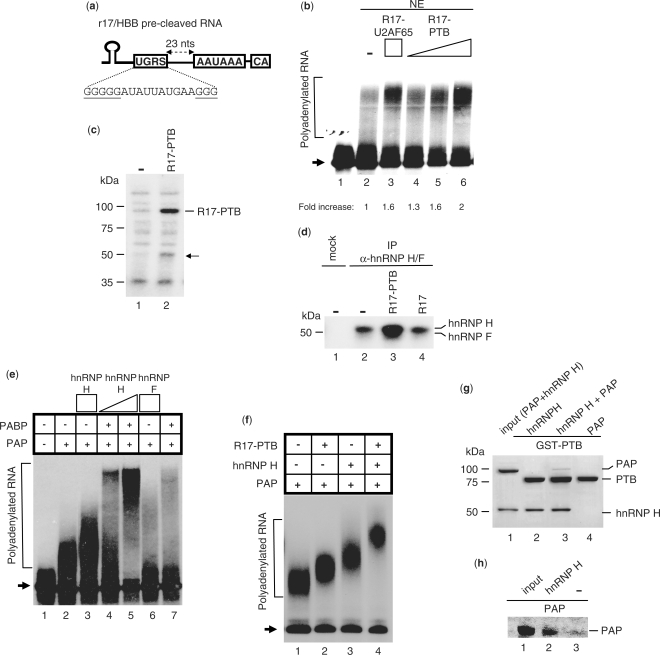Figure 6.
PTB promotes polyadenylation by increasing the binding of hnRNP H to a GRS located upstream of the HBB pA signal. (a) Illustration of the r17/HBB pre-cleaved substrate containing a GRS element upstream of the pA signal (named UGRS). (b) In vitro polyadenylation assays using the 32P-labeled r17/HBB pre-cleaved substrate and NEs in the absence or presence of R17–U2AF65 (10 pmol) or increasing amounts of R17–PTB (2.5, 5 and 10 pmol). Normalized pA efficiency is shown. (c) UV crosslinking of NE proteins using the 32P-labeled r17/HBB pre-cleaved substrate with (5 pmol) or without R17–PTB. The arrow indicates the 50-kDa protein whose binding to the HBB pre-cleaved RNA is increased upon R17–PTB addition. (d) IP of NE proteins UV crosslinked to the 32P-labeled r17/HBB pre-cleaved substrate in the absence or presence of R17–PTB (5 pmol) or R17 (5 pmol) using the hnRNP H/F antibody. (e) Reconstituted polyadenylation assays using the 32P-labeled r17/HBB pre-cleaved substrate, PAP (0.1 pmol) and PABPN1 (1.2 pmol), in the presence of increasing amounts of hnRNP H (2 and 4 pmol) or hnRNP F (4 pmol). Lane 1: input RNA; arrow: non-polyadenylated RNA substrate. (f) Reconstituted polyadenylation assays using the 32P-labeled r17/HBB pre-cleaved substrate and PAP (0.1 pmol), in the presence of R17–PTB (4 pmol) and/or hnRNP H (4 pmol). Arrow: non-polyadenylated RNA substrate. (g) GST pull-down assay to test the interaction between GST-tagged PTB and PAP in the absence or presence of hnRNP H. The input lane accounts for 10% of hnRNP H and PAP used in the assay. (h) IP pull down assay with hnRNP H and PAP using the hnRNP H/F antibody. The input lane accounts for 10% of PAP used in the assay.

